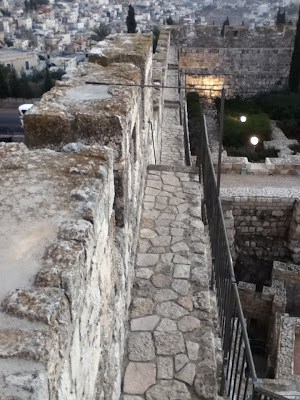Warning: more background info than usual. Feel free to skim.
Masada

After Rome destroyed Jerusalem and the Second Temple in 70 AD, the Great Revolt ended. Masada, inhabited by Zealots who had earlier fled Jerusalem, was the last city to hold out against Rome, surviving another 3 years.

This city was really, really high up and not exactly conducive to agriculture so they stored food in these huge rooms.

Remains of Herod's palace. He fortified Masada in the 30's BC in case of a revolt.



The Romans spent months building this ramp by which they breached the city wall. When they entered the fortress, they found the 960 inhabitants had burned the city and committed mass suicide. Because Judaism strongly discourages suicide, they drew lots and killed each other in turns.


This picture must have been taken long after I'd finished climbing the mountain. I look far too spirited.
Jerusalem. Again.

Dead Sea Scrolls, a collection of 972 documents, including texts from the Bible. The section above is all of Isaiah.

Room of the Last Supper. I apologize for the fuzziness but I didn't have time to adjust my camera settings before a pack of Asian tourists swarmed the room with cameras ablaze.

City of David

This underground tunnel in the City of David leads to the Pool of Siloam (where Jesus sent the man who had been blind from birth). It's at the end of Hezekiah's tunnel, which was built in 701 BC and used by citizens of Jerusalem to safely obtain water. I was mentally prepared to brave the tunnel but chickened out; it was really dark and my only source of light was an Ipod flashlight app.

Pansy route out of the tunnel.
Jerusalem Archaeological Park

Ancient temple steps, leading up to the wall of the Old City of Jerusalem




Remnants of Jerusalem's main street, running the length of the West Wall along about one kilometer, in the late Second Temple period (like when Jesus was there).

Collapsed on the paved streets are stones of the wall of the Temple Mount enclosure. They were hurled down by soldiers of the Roman legion after the destruction of the Temple in 70 AD.


Nerdily thrilled to be exploring underground excavations.
Mount of Olives







No comments:
Post a Comment